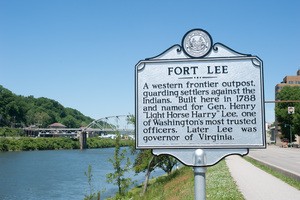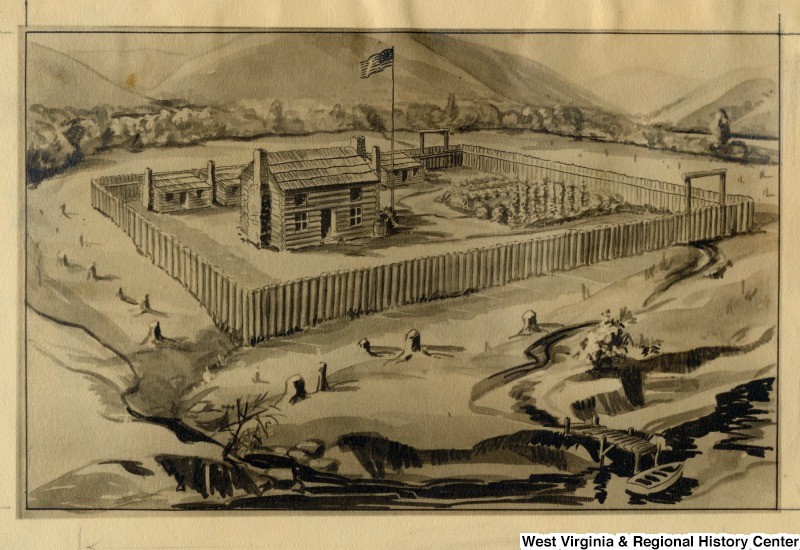Fort Lee Historical Marker
Introduction
Text-to-speech Audio
Images
Sign post for Fort Lee.

A sketch of Fort Lee.

Backstory and Context
Text-to-speech Audio
The first permanent settlement in what would become Charleston was established by an Irish immigrant, George Clendenin in 1788. Others had tried to settle the land prior to Clendenin, but were not successful. George was the son of Charles Clendenin, for whom Charleston, WV is named after. Cuthbert Bullitt sold George Clendenin the 1,030 acre piece of property in 1787, and Clendenin formed a company of rangers with intent of frontier defense so that he could establish a settlement along the Kanawha River. The location of Fort Lee was about 125 feet above what is now the intersection of Brooks Street and Kanawha Boulevard.
Originally known as Clendenin’s Fort, Fort Lee was completed in May of 1788 and was enclosed by a stockade stretching 250 feet by 175 feet. The central structure of the fort belonged to George and his family, and was a two-story hewn-log building considered to be both bullet and arrow proof. The “Mansion House” building was 36 feet by 18 feet, had chimneys at each end, and had two rooms on both the first and second floor. The rangers that accompanied Clendenin established a blockade a mile above the fort, which was where Clendenin’s brother lived. The majority of the rangers were among the first permanent residents of Charleston. In 1972, the fort was renamed Fort Lee in honor of Robert E. Lee’s father, Governor Richard Henry Lee.
After the establishment of Fort Lee, Clendenin convinced the state legislature to form Kanawha County from land then owned by Greenbrier and Montgomery counties. The first county court was housed in the Mansion House, while the first session was held on October 5th, 1789. The justices present at the first session decided to establish a court house at the mouth of the Elk River. Clendenin’s establishment of Fort Lee guaranteed him a permanent position in local government, and was deemed the county lieutenant. In 1790, Clendednin and Andrew Donnally Sr. became the Kanawha County representative for the Virginia House of Delegates.
Fort Lee was established on land belonging to Native Americans prior to the treaty of Fort Stanwix that once again opened up the trans-Allegheny region to settlement. Once the Native Americans noticed the new settlement in the Kanawha River Valley, they began to retaliate to prove that they would not be moved easily. A local legend was created with one of the attacks on Fort Lee. “Mad” Anne Bailey was widowed during the battle of Point Pleasant and after began to wear men’s clothing and drink whiskey to ease her pain. Legend has it that Bailey saved Fort Lee during an attack by riding her horse back to the Greenbrier settlement, obtaining gunpowder, and rushing it back in time to defeat the attackers.
Joseph Ruffner purchase Fort Lee from the Clendenin brothers in 1796, which shortly fell into disrepair. The blockhouse was purchased by John P. Hale in 1872, and moved the structure. On April 1st, 1891, the blockade house belonging to Fort Lee was destroyed by fire. There is a table constructed from the remains of the structure in the State Department of Archives and History.
Sources
Cohen, Stan "Fort Lee." e-WV: The West Virginia Encyclopedia. 30 July 2012. Web. 27 February 2017.
Peyton, Billy Joe. Then & Now: Charleston. Charleston, SC. Arcadia Publishing, 2010.
Charleston: A Capital Experience. Atlanta, Georgia. Riverbend Books, 2000.
Rice, Otis K.. Charleston and the Kanawha Valley. Windsor Publications, Inc, 1981.
Morgan, John G.. Charleston 175. Charleston, WV. The Charleston Gazette, 1970.
Laidley, W. S.. History of Charleston and Kanawha County West Virginia and Representative Citizens. Chicago, IL. Richmond-Arnold Publishing Co..
Rice, Otis K.. Brown, Stephen W.. West Virginia: A History. Lexington, KY. The University Press of Kentucky, 1985.
